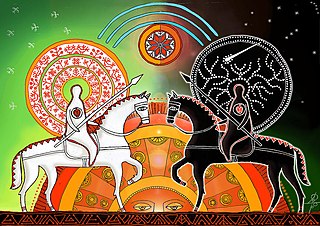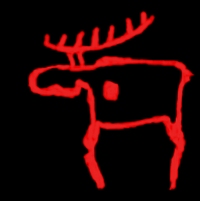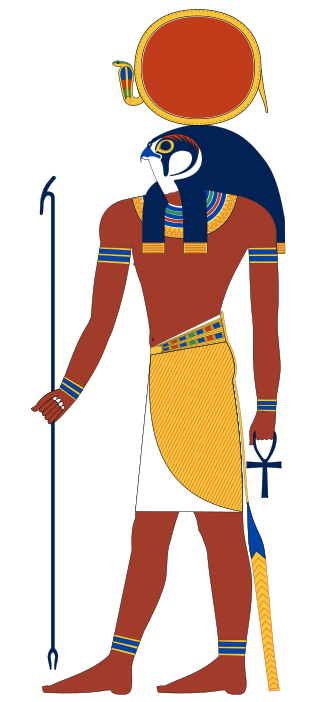
Widewuto was a legendary king of the pagan Prussians who ruled along with his elder brother, the high priest (Kriwe-Kriwajto) Bruteno in the 6th century AD. They are known from writings of 16th-century chroniclers Erasmus Stella, Simon Grunau, and Lucas David. Though the legend lacks historical credibility, it became popular with medieval historians. It is unclear whether the legend was authentically Prussian or was created by Grunau, though Lithuanian researchers tend to support its authenticity.
Sudovian was a Western Baltic language of Northeastern Europe. Sudovian was closely related to Old Prussian. It was formerly spoken southwest of the Nemunas river in what is now Lithuania, east of Galindia and in the north of Yotvingia, and by exiles in East Prussia.

Chernobog and Belobog are an alleged pair of Polabian deities. Chernobog appears in the Helmold's Chronicle as a god of misfortune worshipped by the Wagri and Obodrites, while Belobog is not mentioned – he was reconstructed in opposition to Chernobog. Both gods also appear in later sources, but they are not considered reliable. Researchers do not agree on the status of Chernobog and Belobog: many scholars recognize the authenticity of these theonyms and explain them, for example, as gods of good and evil; on the other hand, many scholars believe that they are pseudo-deities, and Chernobog may have originally meant "bad fate", and later associated with the Christian devil.

Slavic mythology or Slavic religion is the religious beliefs, myths, and ritual practices of the Slavs before Christianisation, which occurred at various stages between the 8th and the 13th century. The South Slavs, who likely settled in the Balkan Peninsula during the 6th–7th centuries AD, bordering with the Byzantine Empire to the south, came under the sphere of influence of Eastern Christianity, beginning with the creation of writing systems for Slavic languages in 855 by the brothers Saints Cyril and Methodius and the adoption of Christianity in Bulgaria in 864 and 863 in Great Moravia. The East Slavs followed with the official adoption in 988 by Vladimir the Great of Kievan Rus'.

Dazhbog, alternatively Daždźbok, Dažbog, Dazhdbog, Dajbog, Daybog, Dabog, Dazibogu, or Dadzbóg, was one of the major gods of Slavic mythology, most likely a solar deity and possibly a cultural hero. He is one of several authentic Slavic gods, mentioned by a number of medieval manuscripts, and one of the few Slavic gods for which evidence of worship can be found in all Slavic tribes.

Old Prussians, Baltic Prussians or simply Prussians were an indigenous tribe among the Baltic peoples that inhabited the region of Prussia, at the south-eastern shore of the Baltic Sea between the Vistula Lagoon to the west and the Curonian Lagoon to the east. The Old Prussians, who spoke an Indo-European language now known as Old Prussian and worshipped pre-Christian deities, lent their name, despite very few commonalities, to the later, predominantly Low German-speaking inhabitants of the region.
Lithuanian mythology is the mythology of Lithuanian polytheism, the religion of pre-Christian Lithuanians. Like other Indo-Europeans, ancient Lithuanians maintained a polytheistic mythology and religious structure. In pre-Christian Lithuania, mythology was a part of polytheistic religion; after Christianisation mythology survived mostly in folklore, customs and festive rituals. Lithuanian mythology is very close to the mythology of other Baltic nations – Prussians, Latvians, and is considered a part of Baltic mythology.
Perkūnas was the common Baltic god of thunder, and the second most important deity in the Baltic pantheon after Dievas. In both Lithuanian and Latvian mythology, he is documented as the god of sky, thunder, lightning, storms, rain, fire, war, law, order, fertility, mountains, and oak trees.

Finnish paganism is the indigenous pagan religion in Finland and Karelia prior to Christianisation. It was a polytheistic religion, worshipping a number of different deities. The principal god was the god of thunder and the sky, Ukko; other important gods included Jumo (Jumala), Ahti, and Tapio. Jumala was a sky god; today, the word "Jumala" refers to all gods in general. Ahti was a god of the sea, waters and fish. Tapio was the god of forests and hunting.

Potrimpo was a god of seas, earth, grain, and crops in the pagan Baltic, and Prussian mythology. He was one of the three main gods worshiped by the Old Prussians. Most of what is known about this god is derived from unreliable 16th-century sources.

Romuva or Romowe was an alleged pagan worship place in the western part of Sambia, one of the regions of pagan Prussia. In contemporary sources the temple is mentioned only once, by Peter von Dusburg in 1326. According to his account, Kriwe-Kriwajto, the chief priest or "pagan pope", lived at Romuva and ruled over the religion of all the Balts. According to Simon Grunau, the temple was central to Prussian mythology. Even though there are considerable doubts whether such a place actually existed, the Lithuanian neo-pagan movement Romuva borrowed its name from the temple.

The Prussian Crusade was a series of 13th-century campaigns of Roman Catholic crusaders, primarily led by the Teutonic Knights, to Christianize under duress the pagan Old Prussians. Invited after earlier unsuccessful expeditions against the Prussians by Christian Polish kings, the Teutonic Knights began campaigning against the Prussians, Lithuanians and Samogitians in 1230. By the end of the century, having quelled several Prussian uprisings, the Knights had established control over Prussia and administered the conquered Prussians through their monastic state, eventually erasing the Prussian language, culture and pre-Christian religion by a combination of physical and ideological force. Some Prussians took refuge in neighboring Lithuania.

Ra or Re was the ancient Egyptian deity of the sun. By the Fifth Dynasty, in the 25th and 24th centuries BC, he had become one of the most important gods in ancient Egyptian religion, identified primarily with the noon-day sun. Ra ruled in all parts of the created world: the sky, the earth, and the underworld. He was the god of the sun, order, kings and the sky.

The so-called Sudovian Book was an anonymous work about the customs, religion, and daily life of the Old Prussians from Sambia. The manuscript was written in German in the 16th century. The original did not survive and the book is known from later copies, transcriptions and publications.

The Prussian mythology was a polytheistic religion of the Old Prussians, indigenous peoples of Prussia before the Prussian Crusade waged by the Teutonic Knights. It was closely related to other Baltic faiths, the Lithuanian and Latvian mythologies. Its myths and legends did not survive as Prussians became Germanized and their culture extinct in the early 18th century. Fragmentary information on gods and rituals can be found in various medieval chronicles, but most of them are unreliable. No sources document pagan religion before the forced Christianization in the 13th century. Most of what is known about Prussian religion is obtained from dubious 16th-century sources.

In Slavic mythology, Perun is the highest god of the pantheon and the god of sky, thunder, lightning, storms, rain, law, war, fertility and oak trees. His other attributes were fire, mountains, wind, iris, eagle, firmament, horses and carts, and weapons. He was first associated with weapons made of stone and later with those of metal.
Kriwe Kriwaito or simply Kriwe was the chief priest in the Baltic mythology. Known primarily from the dubious 16th-century writings of Simon Grunau, the concept of kriwe became popular during the times of romantic nationalism. However, lack of reliable written evidence has led some researchers to question whether such pagan priest actually existed. The title was adopted by Romuva, the neo-pagan movement in Lithuania, when Jonas Trinkūnas was officially installed as krivių krivaitis in October 2002.

Niya is a Lechitic god of the underworld of unknown sex, whose exact functions are unknown. Niya is mentioned together with other gods worshipped by Poles, such as Yesha, Łada, or Devana. Niya's cult may be demonstrated by the sayings "Go to Niye" and "Dwell in Nya" collected by Polish ethnographer Aleksander Brückner. In recent years, the confidence in the authenticity of Niya has increased in the scientific community.














